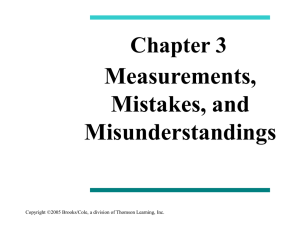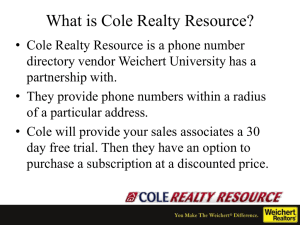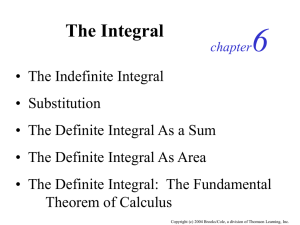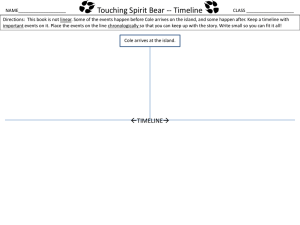Kull_chapter3_lsn 4 - Chemistry at Winthrop University
advertisement
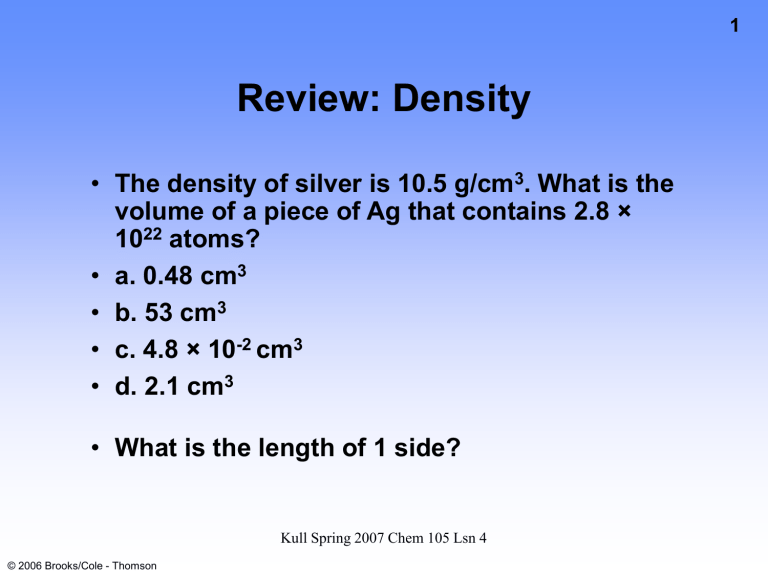
1 Review: Density • The density of silver is 10.5 g/cm3. What is the volume of a piece of Ag that contains 2.8 × 1022 atoms? • a. 0.48 cm3 • b. 53 cm3 • c. 4.8 × 10-2 cm3 • d. 2.1 cm3 • What is the length of 1 side? Kull Spring 2007 Chem 105 Lsn 4 © 2006 Brooks/Cole - Thomson Chemistry and Chemical Reactivity 6th Edition 2 John C. Kotz Paul M. Treichel Gabriela C. Weaver CHAPTER 3 Molecules, Ions and Their Compounds Lectures written by John Kotz Kull Spring 2007 Chem 105 Lsn 4 ©2006 2006 Brooks/Cole Thomson © Brooks/Cole - Thomson 3 3.1 Molecules, Compounds, & Formulas • COMPOUNDS are a combination of 2 or more elements in definite ratios by mass. • The character of each element is lost when forming a compound. • MOLECULES are the smallest unit of a compound that retains the characteristics of the compound. Kull Spring 2007 Chem 105 Lsn 4 © 2006 Brooks/Cole - Thomson Glycine 3.2 FORMULAS and 3.3 Molecular Models 4 • Molecular Formula: C2H5NO2 • Condensed Formula H2NCH2COOH to show atom ordering • structural formula H H O H N C C O H H Ball & stickKull Spring 2007 Chem 105 Lsn 4 © 2006 Brooks/Cole - Thomson Space-filling 3.3 Ionic compounds: Formulas, names, and Properties • Ionic charges (use periodic table) – Desire for noble gas configuration – Cations (+) – Anions (-) • 3.6 What charges are most commonly observed for monatomic ions of the following elements? (a)Selenium (b) fluorine (c) Iron (d) nitrogen Kull Spring 2007 Chem 105 Lsn 4 © 2006 Brooks/Cole - Thomson 5 Charges on Common Ions -4 -3 -2 -1 +1 +2 +3 By losing or gaining e-, atom has same number of e-’s Group 8A atom. Kullas Springnearest 2007 Chem 105 Lsn 4 © 2006 Brooks/Cole - Thomson 6 IONIC COMPOUNDS NH4 7 + Cl Name derived by adding -ide to stem ammonium chloride, NH4Cl Kull Spring 2007 Chem 105 Lsn 4 © 2006 Brooks/Cole - Thomson 8 Note: many O containing anions have names ending in –ate (or -ite). Kull Spring 2007 Chem 105 Lsn 4 © 2006 Brooks/Cole - Thomson Table 3.1, page 107. Some Ionic Compounds Ca2+ + 2 F- ---> CaF2 Mg2+ + NO3- ----> Mg(NO3)2 magnesium nitrate Fe2+ + PO43- ----> calcium fluoride Fe3(PO4)2 iron(II) phosphate (See CD, Screen 3.11 for naming practice) Kull Spring 2007 Chem 105 Lsn 4 © 2006 Brooks/Cole - Thomson 9 Properties of Ionic Compounds Forming NaCl from Na and Cl2 • A metal atom can transfer an electron to a nonmetal. • The resulting cation and anion are attracted to each other by electrostatic forces. • These forces are governed by COULOMB’S LAW. Kull Spring 2007 Chem 105 Lsn 4 © 2006 Brooks/Cole - Thomson 10 Electrostatic Forces COULOMB’S LAW Active Figure 3.10 Kull Spring 2007 Chem 105 Lsn 4 © 2006 Brooks/Cole - Thomson 11 12 Importance of Coulomb’s Law NaCl, Na+ and Cl-, m.p. 804 oC MgO, Mg2+ and O2m.p. 2800 oC Kull Spring 2007 Chem 105 Lsn 4 © 2006 Brooks/Cole - Thomson 13 NONMETALS NONMETAL + n e- ------> Xnwhere n = 8 - Group no. Group 4A Group 5A Group 6A Group 7A C4-,carbide N3-, nitride O2-, oxide F-, fluoride Name derived by adding -ide to stem S2-, sulfide Cl-, chloride Kull Spring 2007 Chem 105 Lsn 4 © 2006 Brooks/Cole - Thomson Br-, bromide I-, iodide 14 3-14 For each of the following compounds, give the formula, charge, and the number of each ion that makes up the compound. (a)K2S (b)CoSO4 (c)CuCO3 (d)Ti(SO4)2 (e)KH2PO4 Kull Spring 2007 Chem 105 Lsn 4 © 2006 Brooks/Cole - Thomson 15 3-16 Platinum is a transition element and forms Pt2+ and Pt4+ ions. Write the formulas for the compounds of each of these ions with (a) chloride ions and (b) sulfide ions. Kull Spring 2007 Chem 105 Lsn 4 © 2006 Brooks/Cole - Thomson 3.4 Molecular Compounds Compounds without Ions CO2 Carbon dioxide CH4 methane BCl3 boron trichloride Kull Spring 2007 Chem 105 Lsn 4 © 2006 Brooks/Cole - Thomson All are formed from two or more nonmetals. Ionic compounds generally involve a metal and nonmetal (NaCl) 16 17 ELEMENTS THAT EXIST AS MOLECULES Allotropes ofLsn C Kull Spring 2007 Chem 105 4 © 2006 Brooks/Cole - Thomson ELEMENTS THAT EXIST AS DIATOMIC MOLECULES Kull Spring 2007 Chem 105 Lsn 4 © 2006 Brooks/Cole - Thomson 18 ELEMENTS THAT EXIST AS POLYATOMIC MOLECULES 19 S8 sulfur molecules White P4 and polymeric red phosphorusKull Spring 2007 Chem 105 Lsn 4 © 2006 Brooks/Cole - Thomson 3.5 Formulas, Compounds, and the mole grams/moles/somethings 20 How many moles of alcohol are there in a “standard” can of beer if there are 21.3 g of C2H6O? a) Molar mass of C2H6O = 46.08 g/mol 1 mol (b) Calc. moles of alcohol 21.3 g • = 0.462 mol 46.08 g How many molecules of alcohol are there in a “standard” can of beer if there are 21.3 g of C2H6O? 6.022 x 1023 molecules 0.462 mol • 1 mol 2007 Chem 105 Lsn 4 = 2.78 x 10Kull23Spring molecules © 2006 Brooks/Cole - Thomson How many atoms of C are there in a “standard” can of beer if there are 21.3 g of C2H6O? There are 2.78 x 1023 molecules. Each molecule contains 2 C atoms. Therefore, the number of C atoms is 23 2.78 x 10 2 C atoms molecules • 1 molecule = 5.57 x 1023 C atoms Kull Spring 2007 Chem 105 Lsn 4 © 2006 Brooks/Cole - Thomson 21 22 3-22 Give the formula for each of the following ionic compounds. (a) Calcium hydrogen carbonate (b) Potassium permanganate (c) Magnesium perchlorate (d) Potassium hydrogen phosphate (e) Sodium sulfite Kull Spring 2007 Chem 105 Lsn 4 © 2006 Brooks/Cole - Thomson 3-34 Calculate the molar mass of each hydrated compound. Note that the water of hydration is included in the molar mass. (a) H2C2O4 2 H2O (b) MgSO4 7 H2O Kull Spring 2007 Chem 105 Lsn 4 © 2006 Brooks/Cole - Thomson 23 24 3-36 Assume you have 0.123 mol of each of the following compounds. What mass of each is present? (a) C14H10O4, benzoyl peroxide (b) Pt(NH3)2Cl2, cisplatin Kull Spring 2007 Chem 105 Lsn 4 © 2006 Brooks/Cole - Thomson 25 3-66 The compound (NH4)2SO4 consists of two polyatomic ions. What are the names and electric charges of these ions? What is the molar mass of this compound? Kull Spring 2007 Chem 105 Lsn 4 © 2006 Brooks/Cole - Thomson 26 68 Kull Spring 2007 Chem 105 Lsn 4 © 2006 Brooks/Cole - Thomson 27 88 Kull Spring 2007 Chem 105 Lsn 4 © 2006 Brooks/Cole - Thomson
